
Marine News' Top Boats of 2020
This year, despite innumerable challenges and setbacks, a great number of new U.S.-flagged vessels made their way into service. In addition to Maid of the Mist's new electric tour boats James V. Glynn and Nikola Tesla featured Wednesday, the newbuilds highlighted below are some of the most noteworthy to come out of U.S. shipyards in 2020.
Dredger
U.S. dredging contractors have been adding tonnage in a big way. This Spring, Callan Marine added a significant piece to the U.S. fleet with its new Jones Act cutterhead suction dredge (CSD) General MacArthur. Upon delivery in May, the new dredge and its accompanying idler barge entered service in Texas, heading to work on several projects before transiting to Corpus Christi for the second phase of a deepening and widening project there.
The newest and largest dredger in Callan Marine’s fleet, the 32-inch General MacArthur represents the next generation of dredging technology and crew comfort, “a complete game-changer for the dredging industry,” according to Maxie McGuire, President of Callan Marine. “We saw a market that could use a large sophisticated dredge, so we designed the MacArthur, which is 100% diesel electric, 24,000 horsepower, and loaded with automation making her a difference-maker in the large dredge market, specifically for capital work, beach/marsh renourishment, and offshore borrow area situations.”
General MacArthur was built in two shipyards. The hull and superstructure construction, housing and assembly took place at C&C Marine and Repair in Belle Chasse, La. The SPI/Mobile Pulley Works shipyard in Mobile, Ala., provided the dredging equipment, including the cutter ladder, A-frame, suction and discharge pipeline, gate valves, submerged dredge pump, two onboard dredge pumps, a five- and a six-blade cutter, Christmas tree, anchor boom system and spud carrier installation. Mobile Pulley Works also provided ball joints and pontoon tanks for the submerged and floating discharge pipeline.
Support vessels and equipment built to serve the new dredge include an anchor barge, idler barge and a large complement of dredge pipeline. In April, Callan Marine launched its new idler barge built in Sterling Shipyard, Port Neches, Texas. Its spud-carriage equipment was then installed at Mobile Pulley Works in Alabama. The idler barge’s dimensions are 180 feet by 54 by 13 and will be connected to the stern of the General MacArthur when dredging in sheltered water. The idler barge is equipped with a spud-carriage and spuds which allow the dredge MacArthur to step over the dredge area as it excavates the seabed’s material. The total stroke of the spud-carriage is 25 feet, the spuds have a length of 110 feet, with weight of 90,000 pounds each.
The General MacArthur is 290 feet long, and with the 180-foot idler barge attached, the dredge has a maximum swing radius of 530 feet. The beam is 72 feet, with a depth 16 feet and 7-foot draft. The digging depth is 97 feet with a suction diameter of 34 inches and a discharge diameter 32 inches. The vessel is equipped with three CAT-MAK diesel electric engines that provide 24,000 horsepower.
Production automation and monitoring systems link to the project and corporate offices, along with Hypack/DredgePack survey software and the Corps of Engineers’ Dredge Quality Management (DQM) system.
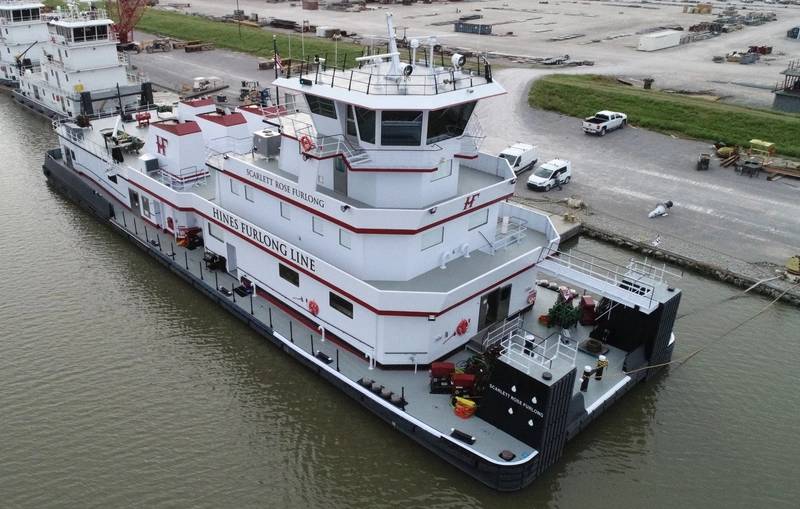 Scarlett Rose Furlong (Photo: C&C Marine and Repair)
Scarlett Rose Furlong (Photo: C&C Marine and Repair)
Towboats
This year saw a number of new and noteworthy towboats enter service on America’s inland waterways. Among those in the leading class of newbuilds is Hines Furlong Line’s 6,600-horsepower triple-screw towboat Scarlett Rose Furlong, delivered in November from C&C Marine and Repair in Belle Chasse, La.
Designed by CT Marine based in Portland, Maine, Scarlett Rose Furlong measures 170 by 50 feet, with the pilot house eyeline measuring at 39 feet, 3 inches.
The vessel includes three Cummins QSK60-M main engines, provided by Cummins Mid-South, that are paired with three Reintjes WAF 1173 H/V reduction gears, provided by Karl Senner, LLC. The service power is provided by three Cummins QSM11-DM, 275 kW generators, and the conventional steering system HPU was provided by EMI Marine. The towboat is outfitted with three 100-inch diameter stainless-steel fixed pitch propellers, provided by Sound Propeller Systems, Inc, and features double steering rudders.
“We wanted the durability of a conventional vessel with both stellar northbound and southbound performance,” Hines Furlong line president Kent Furlong told Marine News. “At the same time, we fully acknowledge the superior maneuverability that Z-drives offer. With all of this in mind, we are convinced that this conventional, kort nozzled setup with the double steering rudder arrangement gets us the best of both worlds.”
The first in a series of thee sister vessels on order at C&C marine, Scarlett Rose Furlong has accommodations totaling 12 beds (11 crew, plus one guest), and the vessel’s design includes a floating, spring mounted superstructure for additional crew comfort.
“These vessels, along with the others we are building, represent a significant capital investment. Moreover, adding brand new, large vessels like this to our fleet make a statement to our existing and future mariners,” Furlong said. “Building the boat is just the start of the process. These vessels represent our continued investment in our steersman program and our ability to promote from within the organization and recruit from the outside. Without a professional crew and the right shoreside team towboats are just a hunk of steel.”
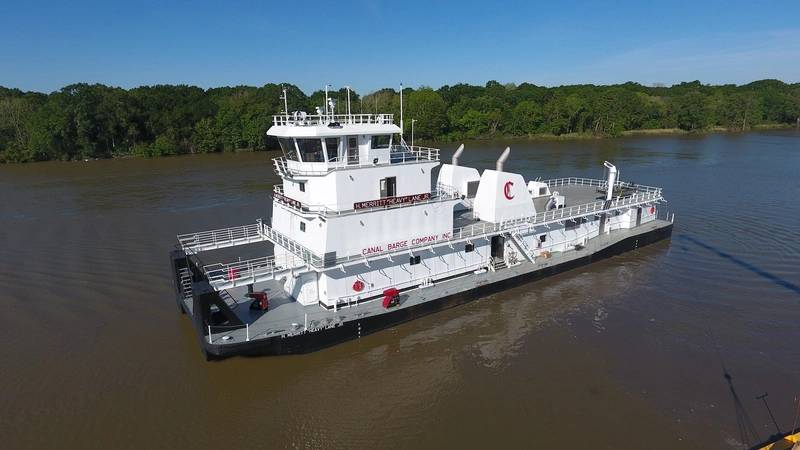 H. Merritt “Heavy” Lane, Jr. (Photo: Conrad Shipyard)
H. Merritt “Heavy” Lane, Jr. (Photo: Conrad Shipyard)
Another noteworthy vessel packing similar power numbers is Canal Barge’s 6,000-horsepower H. Merritt “Heavy” Lane, Jr., handed over from Conrad Shipyard’s Amelia, La. facility in April. The new towboat, which measures 166 feet by 49 by 12 and is powered by EPA Tier IV-compliant Electro-Motive Diesel (EMD) engines, is the flagship of Canal Barge Company’s growing towboat fleet, according to company president and CEO, H. Merritt Lane, III.
“We believe that the Heavy is the first high-horsepower boat on the U.S. Inland Waterways to utilize an EPA Tier IV engine package,” said Ron Zornes, CBC’s Director of Corporate Operations, adding that the need to add high-horsepower tonnage was a driver behind ordering the newbuild. “There are a limited number of higher-horsepower inland towboats of a young enough age that are available for acquisition, so in this case we believe that there was a strong business case to build new for the future.”
The inland towboat H. Merritt “Heavy” Lane, Jr. will work the Lower Mississippi River system primarily, and has the flexibility and versatility to move liquid and dry cargos according to business need, Zornes said.
According to the shipbuilder, the vessel design is based on a proven concept that has been enhanced to modern standards through advanced engineering analysis targeting improved efficiency, crew accommodations and noise reduction.
Designed by naval architects MiNO Marine, the Heavy Lane has a unique hull form to ensure adequate water flow to the propellers in all operating conditions. The design allows the transfer of full power through the propellers, minimizing propeller vibrations transferred to the hull due to unsteady water flow. The design also reduces the potential for flow-induced vibration, ensuring greater crew comfort and reduced noise.
For even greater crew comfort, the superstructure is divided into two sections, one floating and one fixed, and all living accommodations are located in the floating section which sits atop air bellow vibration isolators designed to minimize noise and vibration transmission from the operating machinery. Floating floors in the joiner work reduce vibration as well.
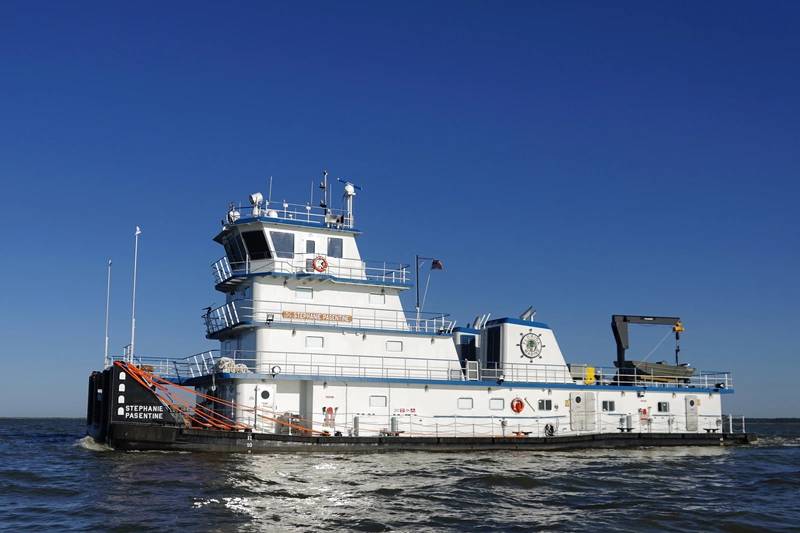 Stephanie Pasentine (Photo: Metal Shark)
Stephanie Pasentine (Photo: Metal Shark)
In May, Metal Shark announced its Bayou La Batre, Ala. shipyard has delivered its first newbuild, a 120 by 35 foot river towboat for Florida Marine Transporters, Inc. (FMT) of Mandeville, La. The four-decked, welded-steel towboat Stephanie Pasentine, which bears the distinction of being Louisiana-based Metal Shark’s first-ever steel newbuild and also its first inland towboat, was designed by John W. Gilbert Associates, Inc.
The vessel’s twin Cat 3512C marine diesel engines deliver 2,011 horsepower each at 1,600 revolutions per minute and turn 100 by 69 inch stainless steel propellers through Twin Disc model MGX5600DR reverse reduction gears with a 6.56:1 ratio. Sleeping accommodations and facilities have been provided for a nine-person crew.
The new towboat is the first delivery in a three-vessel contract with FMT announced in late 2018, signaling Metal Shark’s entry into the inland commercial sector following its acquisition of the assets of Horizon Shipbuilding earlier that year. With the purchase, Metal Shark, best known as a builder of welded aluminum vessels, assumed ownership of a fully developed 35-acre Alabama shipyard and began to expand into steel shipbuilding.
 Atlantic Endeavor (Photo: Atlantic Wind Transfers)
Atlantic Endeavor (Photo: Atlantic Wind Transfers)
Crew transfer vessels
The future is bright for America’s offshore wind industry, with a number of projects slated to sprout up along the U.S. East Coast in the years ahead. Necessary to support operations at these wind farms will be a new fleet of crew transfer vessels (CTV), two of which entered the water in 2020.
After taking delivery of the first ever Jones Act CTV in 2016, Atlantic Wind Transfers returned to Blount Boats for its second, Atlantic Endeavor, recently launched at the venerable Warren, R.I. shipyard. This new Chartwell 24 CTV, designed by Chartwell Marine in the U.K., will be heading to the Coastal Virginia Offshore Wind (CVOW) project for Dominion Energy to support the two Siemens Gamesa turbines 27-miles off Virginia Beach. AWT, based in Quonset Point, R.I., has a long-term O&M CTV contract with Dominion Energy for CVOW project support, and Atlantic Endeavor will be based out of Virginia’s Hampton Roads region.
The 64.9-foot aluminum catamaran, powered by MAN engines that drive HamiltonJet waterjets, is capable of service speeds of 22-24 knots and a top speed of 29 knots. It will be manned by a crew of two or three, and it has capacity to carry up to 24 wind farm personnel.
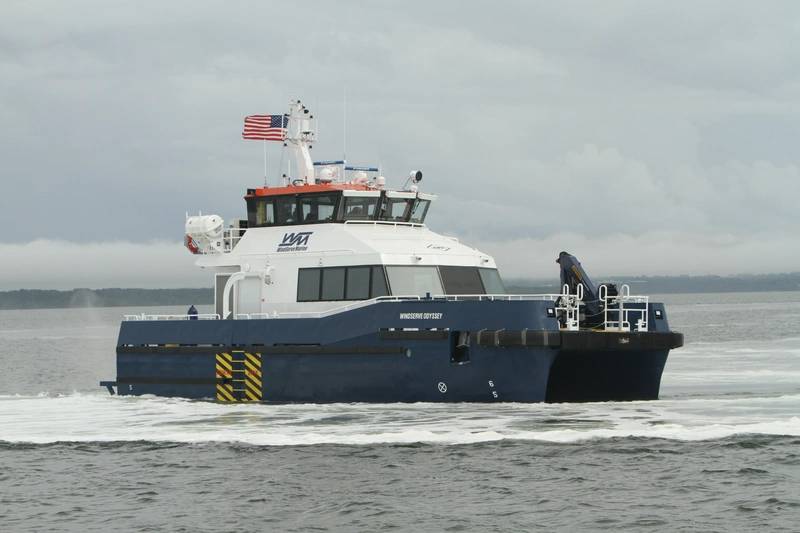 WindServe Odyssey (Photo: WindServe Marine)
WindServe Odyssey (Photo: WindServe Marine)
The other CTV to join the Jones Act fleet this year is WindServe Marine’s WindServe Odyssey, built by Reinauer Group sister company Senesco Marine in North Kingstown, R.I. The newbuild will support Ørsted ‘s U.S. offshore wind projects along the U.S. East Coast. After sea trials at Ørsted’s Block Island Wind Farm earlier this year, the CTV travel from Rhode Island to Virginia to join the closeout of construction and commissioning of the CVOW project. However, the vessel has been built specifically for Ørsted’s and Eversource’s Revolution Wind project located off the southern New England coast, expected to be commissioned in 2023.
The 64.9-foot aluminum catamaran, designed by BMT Group, is capable of 25 knots service speeds and a top speed around 28 knots. WindServe Odyssey is powered by four 800-horsepower Scania engines four paired with HamiltonJet waterjets. It is manned by a crew of two, with capacity to carry up to 20 wind farm personnel.
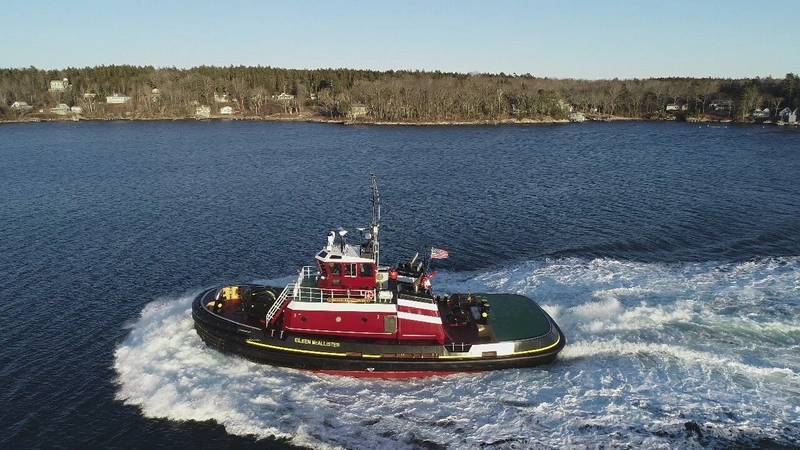 Eileen McAllister (Photo: McAllister Towing)
Eileen McAllister (Photo: McAllister Towing)
Tugs
As the ships that call U.S. ports continue to grow larger, the U.S. tugboat fleet will need to keep pace. Higher-horsepower, sturdier and more capable vessels are being designed and built to handle the challenge.
In April, McAllister Towing took delivery of the 6,770-horsepower shipdocking tug Eileen McAllister, built for work in Port Everglades, Fla. The 34th tractor tug in McAllister’s fleet, the 93- by 38-foot Eileen McAllister was built by Washburn & Doughty in Maine. It is powered by 3516E Tier IV Caterpillar engines with twin Schottel SRP 490 Z-drives and Markey winches, achieving more than 84 metric tons during bollard pull certification.
Captain Chuck Runnion, McAllister Towing of Port Everglades’ Vice President and General Manager, said, “The Eileen McAllister was constructed specifically to meet the needs of handling the ever-increasing size of vessels calling into Port Everglades. This tug, along with the Tate McAllister, will be able to safely handle these ships and even larger ones with exceptional control and power.”
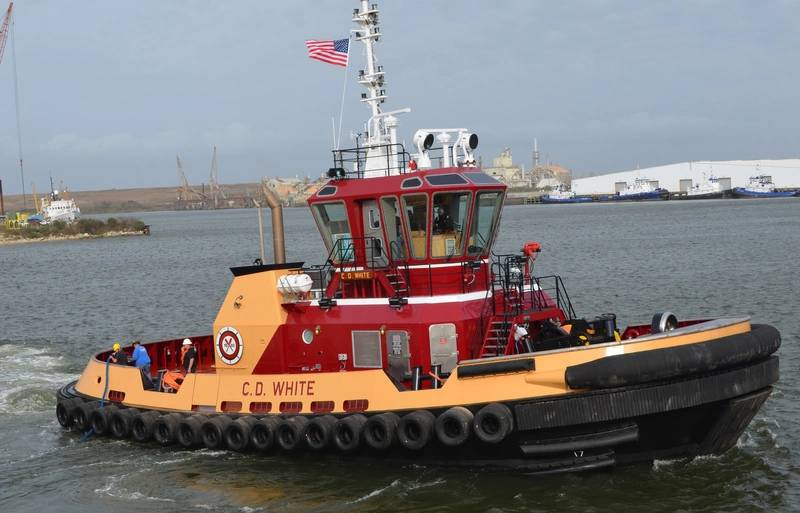 C.D. White (Photo: Eastern Shipbuilding)
C.D. White (Photo: Eastern Shipbuilding)
This year, Eastern Shipbuilding in Panama City, Fla., delivered not one, but two 80-foot, 5,100-horsepower Z-drive tugs for Bisso Offshore, a division of E.N. Bisso & Son of New Orleans, La. The first of these vessels, C.D. White, was delivered in January, followed by A. Thomas Higgins in August. The two new Robert Allan Ltd.-designed RApport 2400 ship-handling tugs have been customized by the designer, the builder and owner to provide specific operational features including a high bollard pull forward and aft, enhanced maneuverability and escort performance, better fuel economy, crew comfort, safety under the new USCG Sub-M requirements and reduced emissions meeting the new EPA Tier 4 emissions regulations.
Each tug is equipped with two LA CAT, Caterpillar 3512E Tier 4 EPA/IMO III marine propulsion diesel engines, delivering 2,550 horsepower at 1,800 revolutions per minute, driving Kongsberg/Rolls Royce US205 P20 Z-drives. Each vessel also features a pair of Kennedy Engines Co. John Deere 4045AFM85 Tier 3 EPA certified auxiliary diesel gensets rated to 99 kilowatts at 1,800 revolutions per minute, as well as Markey Machinery winches.
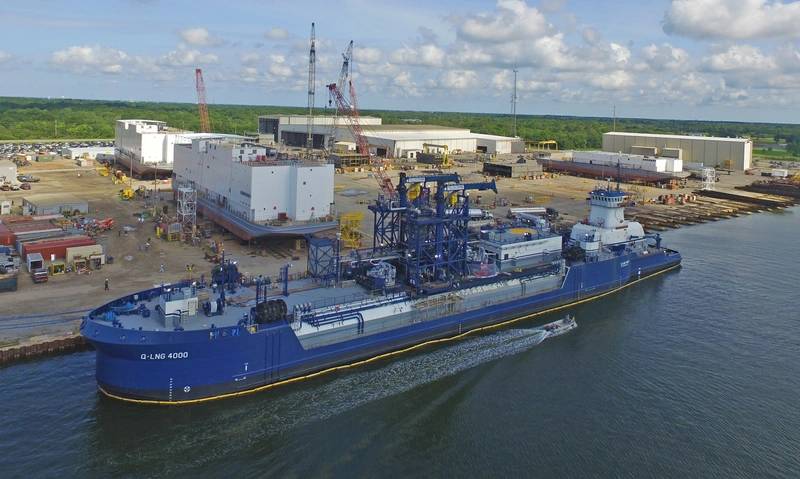 Q-LNG 4000 and tug Q-Ocean Service (Photo: Q-LNG)
Q-LNG 4000 and tug Q-Ocean Service (Photo: Q-LNG)
ATBs
Q-LNG Transport’s new articulated tug barge unit (ATB) is the first of its kind. The barge Q-LNG 4000 and tug Q-Ocean Service, both built by Halter Marine in Pascagoula, Miss., form the first ever liquefied natural gas (LNG) ATB built in the U.S.
The Jensen Maritime-designed tug is 128 by 42 feet with a molded depth of 21 feet. It will operate while fitted in the stern notch of the 324- by 64-foot, 4,000-cubic-meter-capacity barge designed by Waller Marine. The barge has a molded depth of 32.5 feet. Both vessels’ detail design was done by Halter Marine under mutual agreements.
The ATB is the first to attain a DPS-1+ notation from ABS. This rigorous review allows the vessel to operate without additional support in close proximity of other vessels, adding flexibility to deliver LNG fuel in open water and other conditions that would be otherwise inaccessible. Shane Guidry, principle owner of Q-LNG, said, “We believe this vessel’s DPS-1+ notation raises the bar in safety, efficiency and compatibility in the LNG bunkering market.” he added, “This is a moment in maritime history we are proud to be part of.”
Shell has signed a long-term charter for Q-LNG 4000, which will operate out of Port Canaveral, Fla. Initial clients for the new vessel will be Carnival Cruise Line’s two new dual-fuel ships and two dual-fuel Siem Car Carrier ships under charter to the Volkswagen Group to transport vehicles from Europe to North America.
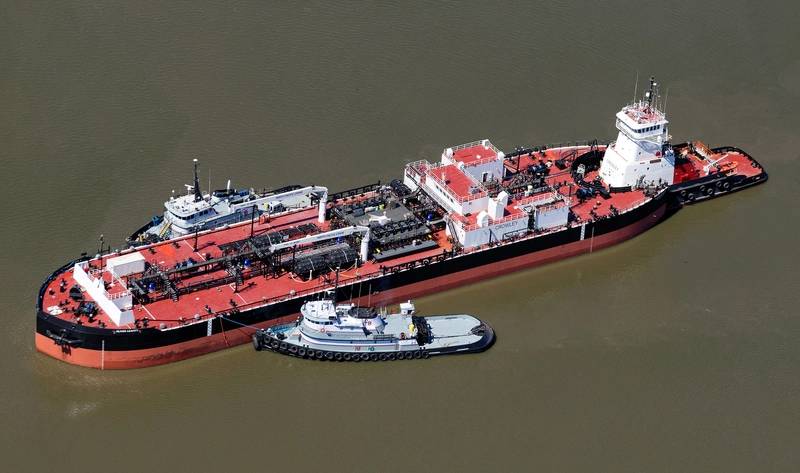 Oliver Leavitt and Aveogan (Photo: Bollinger Shipyards)
Oliver Leavitt and Aveogan (Photo: Bollinger Shipyards)
In April, Crowley Fuels took delivery of its new Alaska Class 100,000-barrel, articulated tug and barge (ATB), which will be used to transport petroleum products for the Alaska market, from Bollinger Shipyards. The barge Oliver Leavitt and tug Aveogan pairing form the first ATB in Crowley’s fleet dedicated to the Alaska market. Crowley will operate the 483-foot ATB under long-term charter for Alaska-based Petro Star Inc., a wholly owned subsidiary of Arctic Slope Regional Corporation.
The ATB was constructed at the Bollinger Marine Fabricators facility in Amelia, La., with on-site construction management by Crowley Shipping, whose subsidiary Jensen Maritime designed the ATB to meet Ice Class and Polar Code requirements. This includes increased structural framing and shell plating and extended zero discharge endurance. The double-hulled design also features a barge form factor to achieve high-cargo capacity on minimal draft.
The 7,000-horsepower tug has twin azimuthing drives and an Intercon C-series coupling system with a first-of-its-kind lightering helmet. The tug is fitted with two GE 8L250 main engines that meet EPA Tier 4 emissions standards. The generators on the tug and barge meet EPA Tier 3 and IMO Tier II emissions standards.
In addition, the ATB features a patent-pending closed loop, freshwater ballast system whereby the tug’s ballast will be transferred to-and-from a retention tank on the barge to account for fuel burn. The design has been approved by the USCG and will eliminate the need to discharge tug ballast water into the sea.
The 128- by 42- by 21-foot tug is equipped with a fire monitor and foam proportioner, providing off-ship firefighting capabilities to the barge. The 400- by 85- by 32-foot barge is also outfitted with spill response gear and a hydraulic boom reel with 2,000 linear feet of inflatable boom to support spill response efforts. The vessel was built with enhanced features to benefit the crew, including 45-degree sloped staircases, interior sound deadening and dedicated heads in each cabin.
 Captain Murchison (Photo: All American Marine)
Captain Murchison (Photo: All American Marine)
Patrol boat
Among the most capable vessels delivered this year is an aluminum catamaran built by All American Marine, Inc. (AAM) to patrol Texas state and federal waters for the law enforcement division of Texas Parks and Wildlife Department (TPWD).
The 80- by 27-foot Captain Murchison features twin CAT C18 ACERT D Engines, with HamiltonJet HM 521 waterjets and is built to USCG Subchapter T standards. It is also the first vessel in North America to feature HamiltonJet’s innovative Advanced Vessel Control (AVX) system, which includes both a station keeping and a JETanchor positioning system. Additional vessel features include a DJI Mavic Drone integrated to the helm displays, as well as a FLIR M400 XR high-resolution thermal imaging video with tracking to assist with patrol duties in the Gulf of Mexico.
The state-of-the-art hydrofoil assisted vessel, from Teknicraft Design, combines innovative design features critical to modern maritime law enforcement. One such feature is the inclusion of Teknicraft ’s Rapid RHIB launching system integrated into the stern of the vessel to increase safety and reduce the time and manpower required to deploy the vessels’ rigid hull inflatable boat (RHIB). Notably, it will allow for deployment and retrieval in under 1 minute. The RHIB is a 20-foot Willard with a 170-horsepower Volvo diesel engine, and also features HamiltonJet propulsion.
This new vessel fills a vital role in the enforcement of environmental and patrolling responsibilities.
TPWD is responsible for patrolling state waters of Texas, out to 9 nautical miles in the Gulf of Mexico. However, TPWD and Texas Game Wardens also patrol an additional 200 nautical miles into exclusive economic zones through a joint enforcement agreement with the National Oceanic and Atmospheric Agency (NOAA).
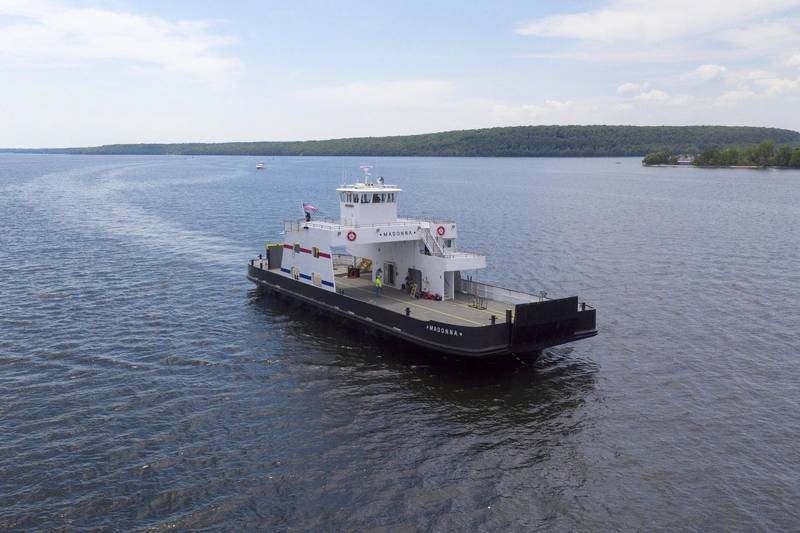 Madonna (Photo: Fincantieri Bay Shipbuilding)
Madonna (Photo: Fincantieri Bay Shipbuilding)
Ferry
In June, Fincantieri Bay Shipbuilding delivered a new, year-round passenger/vehicle ferry for service to the Washington Island community across the Death’s Door Passage between the Bay of Green Bay and Lake Michigan. At 124 feet in length, 40 feet in beam and 9 feet in draft, and with capacity for up to 28 vehicles and 150 passengers, Madonna is the largest vessel in the Washington Island Ferry fleet, allowing crews to operate a spacious second ferry with year-round capabilities. This newest ferry design incorporates ice capabilities in addition to adding significant vehicle capacity.
“With a similar design to the Arni J. Richter, which Fincantieri Bay Shipbuilding built for us in 2003, the Madonna allows us to run a second, year-round ferry with icebreaking capabilities,” said Washington Island Ferry Line President Hoyt Purinton.
Twin CAT-C32 main engines provide 1,600 maximum horsepower while its stainless propellers and shafts (and stout framing) make it ice-capable. Outdoor, upper deck seating and an indoor, climate-controlled cabin are available to passengers, along with restrooms on two decks. Bow and stern ramps with wide gates allow for easy vehicle loading. The Madonna also has an overhead of 15 feet, sufficient to transport high-clearance specialty equipment and large oversized loads as needed.
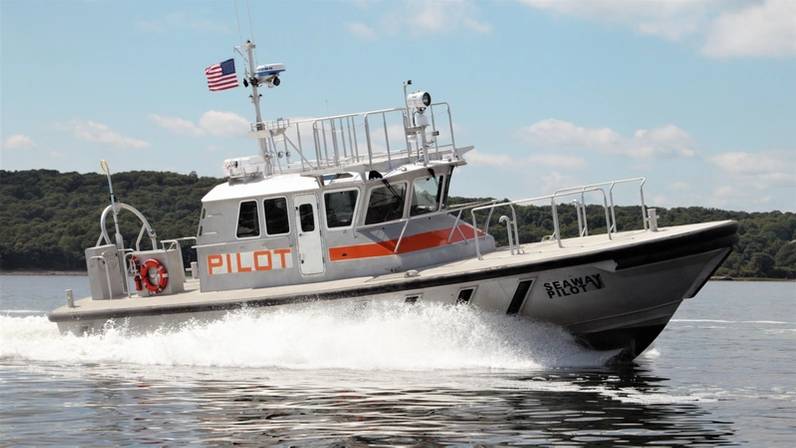 Seaway Pilot V (Photo: Gladding-Hearn Shipbuilding)
Seaway Pilot V (Photo: Gladding-Hearn Shipbuilding)
Pilot boat
In August, Gladding-Hearn Shipbuilding, Duclos Corporation delivered Seaway Pilot V, a Chesapeake class pilot boat to the Seaway Pilots Inc. in Cape Vincent, N.Y. The Seaway pilots navigate ships in and out of the ports and harbors of the St. Lawrence Seaway between St. Regis, N.Y. and Port Weller on Lake Ontario.
With a length overall of 53.6 feet, a beam of 17.8 feet and a draft of 4.8 feet, the all-aluminum pilot boat features the Ray Hunt Designs deep-V hull. It is powered by twin keel-cooled Volvo Penta D16, EPA Tier 3-compliant diesel engines, each delivering 641Bhp at 1,800 rpm and a top speed of 23 knots. A Humphree interceptor trim-tab control system, with Automatic Trim Optimization is installed at the transom. Diesel capacity is 800 gallons, which shipyard officials said will provide a range of at least 300 miles at an economical speed of about 20 knots.
The engines turn five-blade NiBrAl propellers via ZF500-1-A gear boxes. The launch is equipped with a keel-cooled 12-kilowatt Northern Lights EPA Tier 3-compliant genset.
The wheelhouse, mounted to the flush deck amidships, features a center-line helm station, heated forward, side and roof windows, five Llebroc seats and a settee. It is heated/cooled by a 32,000 Btu reverse-cycle air-conditioning system. The decks, handrails and cabin are heated by a 100,000 Btu diesel-fired hydronic heating system, augmented by main engine waste heat.
Outside of the wheelhouse are wide side decks, side and rear doors, and heated roof and boarding platforms on the roof. Because of season icing, the launch’s bottom has extra-thick plating. At the transom are throttle and steering controls, and a winch-operated, fixed davit over stairs to a recessed platform for rescue operations.
Read Marine News' Top Boats of 2020 in Pdf, Flash or Html5 edition of December 2020 Marine News
Other stories from December 2020 issue
Content
- US Inland Waterways: Cheer the Year! page: 8
- Wasted Words: Post-casualty Apologies Are ‘Sorry’ Excuses page: 10
- RIBs: Turn Up the Power page: 12
- Digital Twins: Rivers, Oceans, Harbors Recreated page: 18
- Marine News' Top Boats of 2020: James V. Glynn and Nikola Tesla page: 22
- Marine News' Top Boats of 2020 page: 26
- US Coast Guard Surf Boats: Service Life Extension page: 38
- Out-casting and Outlasting the Competition page: 40


